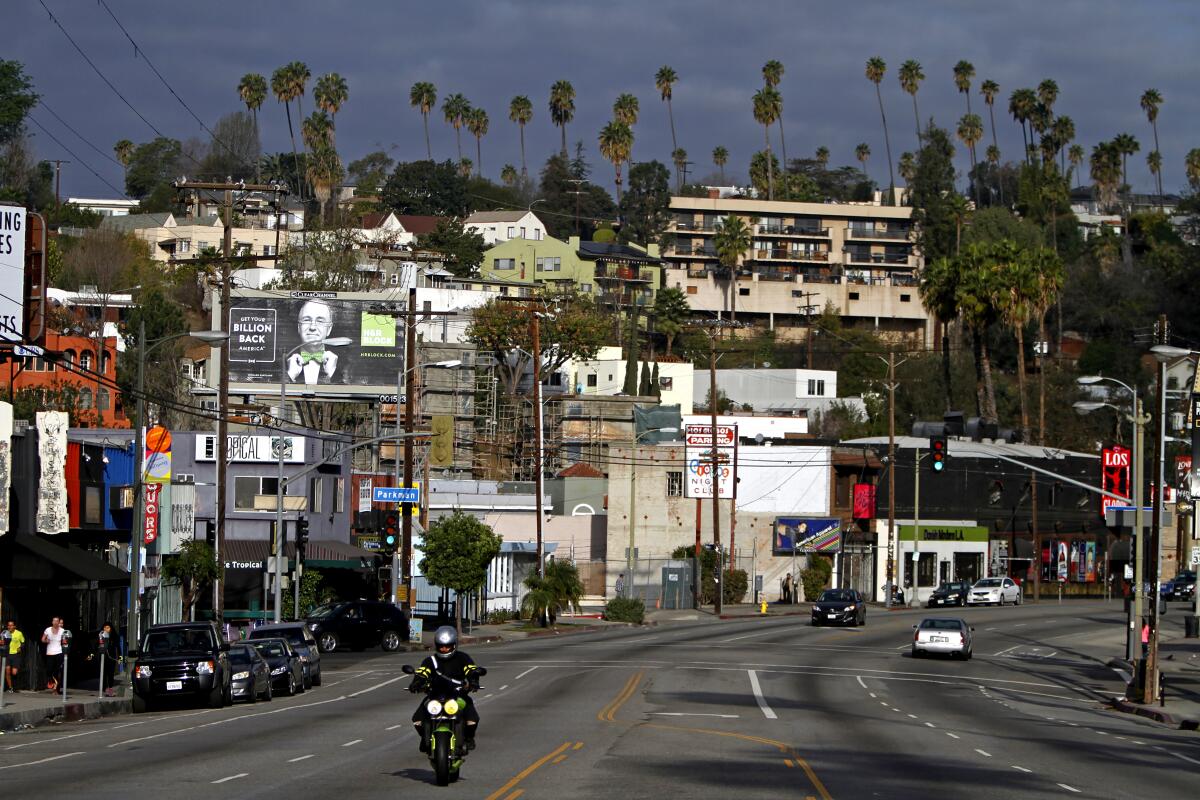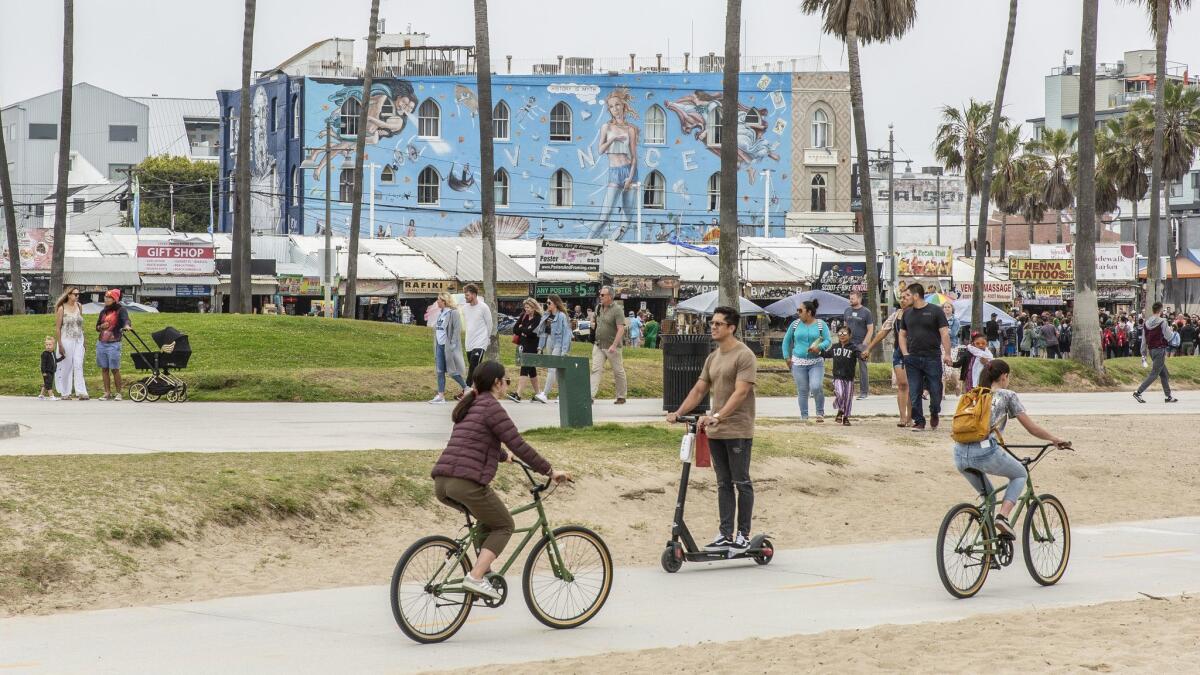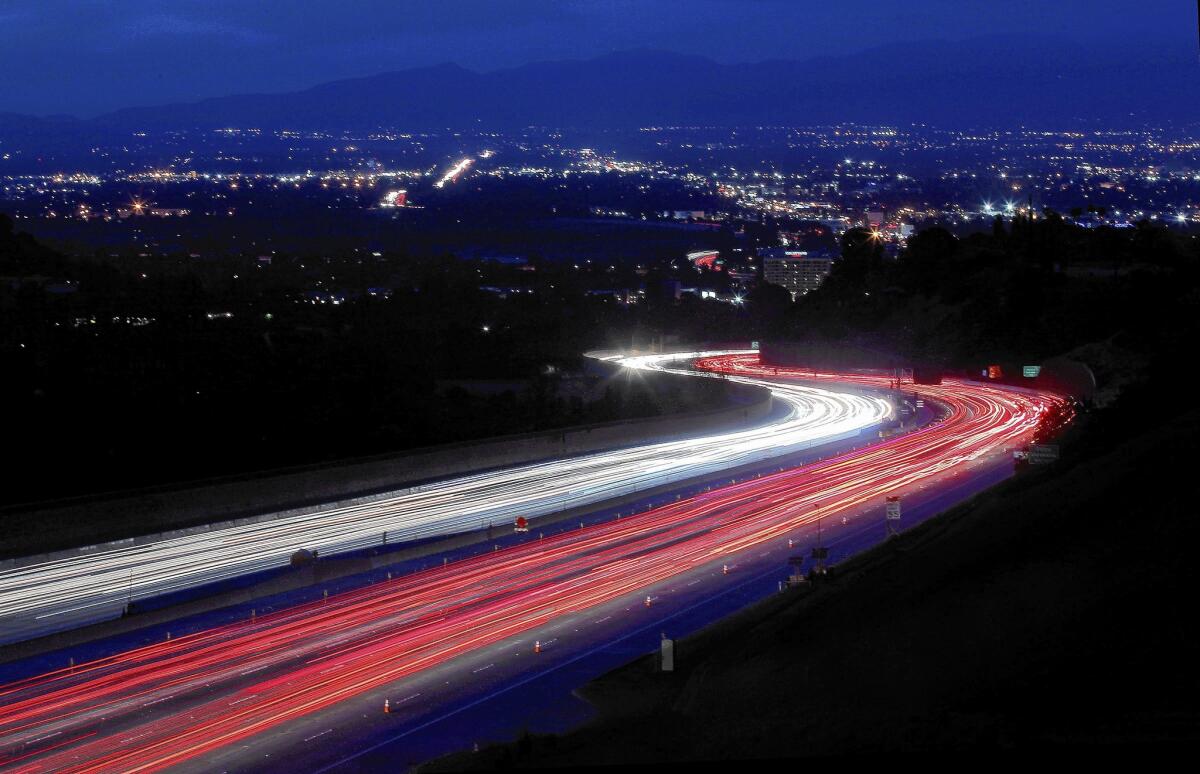A New York writer asked ‘L.A. Twitter’ where she should live. It didn’t go well

- Share via
It was totally an innocent question. She promises.
Taylor Lorenz, a New York Times Style reporter known for cheeky but astute explainers on online youth culture, tweeted an innocuous query to her 171,000 followers that set off — true to the high-wire tensions of the web these days — an avalanche of indignant responses.
“LA Twitter,” Lorenz wrote, “Everyone says Silverlake, Echo Park, and Los Feliz are the best places to live in LA. But why not Santa Monica or Venice? Wouldn’t u wanna be near the beach if u live in CA? Just something I’ve been wondering”.
The replies were, uh, impassioned. Hundreds weighed in, revealing a complexity of emotions and biases that inform any hot take about the social and cultural landscape of urban Los Angeles.
“I feel like non-LA people just don’t understand how infrequently LA people go to LA beaches,” responded Haley Potiker, who works in communications for a local union.
“A not perfect at all analogy would be ‘Everyone says Williamsburg, Bushwick and Greenpoint are the best places to live. But why not Upper East or Upper West Side? Wouldn’t you wanna be near Central Park if you live in NY?’” wrote Nicolas Gonzalez, offering actually a near-perfect analogy for Lorenz’s lens on L.A.
“Not criticizing you but you may be getting slanted intel,” he added.
Another said: “This thread is peak LA. Everyone thinks every place is awful besides where they live.”
In Los Angeles, needling a New Yorker’s cluelessness about L.A.’s geography has become something of an internet pastime. Especially in recent years, as the city grapples with what often feels like an unending stream of plopped-in arrivals from New York, the country’s cockiest metropolis.
Angelenos have a stereotype about these folks: people who ceaselessly, often ridiculously try to define every central neighborhood in L.A. with an analogous counterpart in New York.
Although Lorenz was tweeting for her own reconnaissance mission, her question unleashed for many the memories of an embarrassing string of New York Times pieces, largely in the Travel and Real Estate sections, that make L.A. sound like an alien kingdom, devoid of history or meaning that doesn’t involve a New Yorker’s stamp of approval.
One such story referred to Olvera Street as little more than the source of “all useless items in the world,” resulting in an apology from its writer and editors. Other pieces recycle the tropes of L.A.’s supposed lack of pedestrian culture, or its epic traffic, or the symbols of palm trees and plastic surgery. “What is Los Angeles?” one New York Times writer recently asked, as if the mere existence of this place was too much for the brain to bear.
Little wonder L.A. Twitter was triggered.
Reached this week at home in New York, Lorenz admitted that her question was maybe too innocent for the knives-out climate surrounding the New-Yorkers-on-Los-Angeles problem.
“I was just looking at a map of L.A. trying to be like, ‘Hmm, where should I even start looking?’” Lorenz said. “This is before I was even looking at prices.”
The writer is moving to L.A. because much of her area of coverage lately is centered here, where she flies in, takes Ubers and chases TikTok stars at mansions in Calabasas or the Hollywood Hills. (Disclosure: This reporter briefly overlapped with Lorenz on the staff of the New York Times Style section last fall.) Regarding her tweet, she said she honestly needed the guidance.
“I didn’t realize some of the challenges these communities are facing with gentrification,” Lorenz said. “My whole family is from New York. I’m deeply aware of those issues in New York.”
Just prior to this L.A. Twitter storm, Lorenz was facing an aggressive doxxing campaign for her reporting work. On July 1, her name came up in a conversation on the invite-only live-audio app Clubhouse, in which members derided the “right” of Lorenz, and journalists at large, to question or “cancel” venture capitalists and Silicon Valley tech leaders. Since then, powerful VC figures have attacked her character. It’s easy to understand why she might want a nice home retreat.
The reporter said she probably won’t live in any of the neighborhoods mentioned in the original tweet, realizing that all of them — even once-scrappy Echo Park — are out of her price range. “The places I saw in Los Feliz were not that much cheaper than places in Venice, so I kind of got the sense [the replies were] more of a beef between areas,” Lorenz said.
And what a beef it was. The Twitter storm also revealed deeply entrenched stereotypes that Angelenos harbor about one another, along hard geographical lines. Many respondents, cruelly, called the Santa Monica and Venice shorelines smelly, ugly or worse. (“It was a lot of Westside bashing,” the reporter marveled.)
“Anything west of the 405 might as well be North Korea for how likely I am to visit,” tweeted screenwriter Sam Laskey.

More serious replies accused Lorenz of ignoring lower-income or non-white native Angelenos by using the euphemism of “everyone” to mean people like her: outsiders with enough mobility to move to California, which in 2018 had the highest rental housing prices of any state, according to the U.S. Bureau of Economic Analysis.
“It’s erasure rooted in white supremacy,” tweeted journalist Aura Bogado.
Times staff writer Esmeralda Bermudez responded with a truism repeated throughout the mini-controversy, that L.A., in its spatial vastness, is far richer than the neighborhoods where privileged arrivals from the East Coast tend to congregate — a handful of locales compared to the 272 ’hoods, cities or unincorporated places that are currently designated by The Times’ neighborhood mapping project.
“Been in L.A. since I was a kid. I’ve never lived or had any interest in living in any of these places,” Bermudez replied to Lorenz. “L.A. is so much more than these neighborhoods, though it’s often all transplants choose to see.”
For other hardened Angelenos, the Lorenz tweet reflected the shifting edges of “cool” and “up-and-coming” in a city characterized by constant layering, upheaval and displacement. Pat Saperstein, an editor at Variety and founder of the old-school blog Eating L.A., grew up in Santa Monica and lived in the Melrose area when it was the absolute hippest — in the 1980s.
She then moved to Silver Lake, or the area she tried at one point, unsuccessfully, to normalize as the Near Eastside (reminder: “Eastside” should only be used for places east of the L.A. River). Saperstein said she explicitly avoided weighing in on the Lorenz tweet controversy, saying, “We’ve litigated it so many times.” Today she lives in Echo Park.
“A decade or two ago, everyone wanted to be in Santa Monica or Venice, that’s why those areas are so incredibly expensive; then they went to Silver Lake so they could afford it, and now that area is attractive to a whole other group of people,” Saperstein said.
And judging from the machinations of the local real estate market, the boundary of the next-edgy ’hood has arguably already left places like Echo Park behind. “In my neighborhood there are huge houses going up that are now selling for close to $3 million, which is just insane,” Saperstein said.
It’s possible, she added, that defensiveness about the coolness factor of Los Feliz, Silver Lake and Echo Park is rooted in the anguish over the trifecta’s inevitable de-cooling. “I think it’s starting to get those characteristics that people don’t like about the Westside,” Saperstein said, adding that she has no intention of leaving.
In that regard, others noted, the Westside is also too often dismissed by so-called new Eastsiders, or anyone who refuses to acknowledge that the Westside is not simply rich, white and recent.
“L.A. is a big, vibrant, wonderful city that has great neighborhoods in the Eastside, the Westside and even the fake Eastside that all the gentrifiers live in is really nice,” said Eric Nusbaum, a Culver City native and author of “Stealing Home,” a new book about the displacement of working-class residents in Chavez Ravine for the construction of Dodger Stadium. “I don’t like the superiority that people have, because there’s a lack of curiosity in that.”

Lorenz seemed to take the raking gamely. The use of “everyone” in her L.A. tweet, she admitted, landed wrongly: She actually meant a casual group chat with friends who already live in Los Angeles. As far as the Westside vs. Eastside battle in L.A., Lorenz offered another New York analogy, because of course.
“People in Brooklyn talk a lot of [crap] on Manhattan, and people in Manhattan just don’t care,” she said.
The roasting she took by L.A. Twitter users, she said, was more instructive than any piece of advice she’s gotten on where to move. “I’m scared of L.A. Twitter now,” Lorenz laughed. “I always thought New York Twitter is the most intense Twitter, and this literally felt like I was being introduced to L.A. Internet.”
Meanwhile, her search continues. Somewhere in the Valley, she said in all seriousness, suddenly sounded nice.
More to Read
The biggest entertainment stories
Get our big stories about Hollywood, film, television, music, arts, culture and more right in your inbox as soon as they publish.
You may occasionally receive promotional content from the Los Angeles Times.











